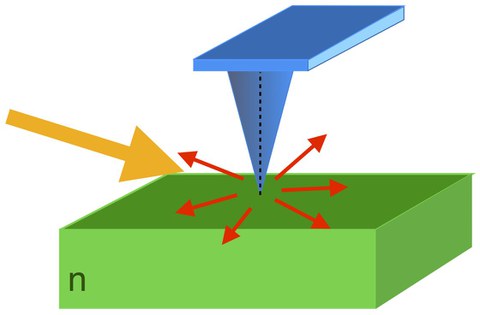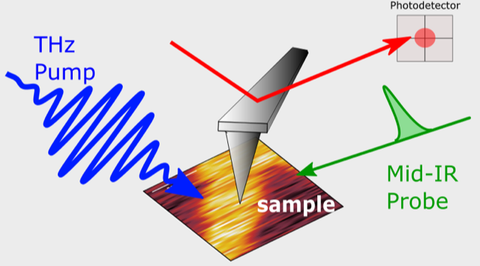Jul 11, 2019
BMBF funding in the area of optical near-field microscopy
The Federal Ministry of Education and Research (BMBF) provides the Chair of Experimental Physics/Phtophysics with more than 1.5 million euros for the second funding period of the research projects "NanOMap II" and "TinNa II".
Scanning near-field infrared microscopy (SNIM) enables the spectroscopic and surface-sensitive probing of materials with a wavelength-independent lateral resolution of 30 nm. Particularly in the IR to THZ regime, this allows for the examination of nanoscopic structures with a resolution much smaller than the wavelength, which can not be accessed with conventional microscopy due to the wave nature of light. Applications of this method include materials sciences, bio-, nano-, energy- and semiconductor-technology as well as nanoscale photonics.
The combination of SNIM with the IR-to-THz free-electron laser FELBE allows us to address resonances in materials, enhancing significantly the sensitivity of the method. Here, we particularly address a regime of the electromagnetic spectrum that is not accessible with conventional light sources, but that is of urgent interest for excitation of polariton modes determining materials' fundamental behavior. Consequently, this unique technique, which we apply at room temperature as well as at low temperatures,
enriches the fundamental characterization of matter.
NanOMap II
In the project "NanOMap II - Nanoscopic Optical Material Probing at FELBE", managed by Dr. Susanne Kehr, a new commercial near-field microscope at FELBE will be implemented, which on one hand enables unique additional measurements and on the other hand is explicitly suitable for external users of the facility. In addition to the integration of the new instrument at FELBE, its capabilities will be demonstrated by addressing current scientific questions and by optimizing the user operation in pilot
experiments with external collaborators. After successful conclusion of this project, nanoscopic infrared examination of materials will be permanently available to external users of FELBE, allowing for lateral resolution of 30 nm in the wavelength regime from
4 to 250 μm at temperatures between 4 and 300 K.

High-resolution material analysis under ifrared illumination by the free-electron laser FELBE. Within the project NanOMap II, a user-friedly microscope will be integrated.
TiNa II
The main objective of the project "TiNa II - Time-resolved Nanoscopy in the deep THz regime" is to boost the development and application of THz Nanoscopy using the
THz sources of the ELBE linear accelerator. Therefore time-resolved scattering-type near-field microscopy will be implemented for studying ultrafast dynamical processes induced by intense THz radiation with < 30 fs time resolution and < 50 nm spatial resolution. Moreover, these novel methods will be applied to elucidate novel physics of modern-type complex quantum materials as such topological insulators, 2D materials,
magnonic materials, Dirac- and Weyl semimetals.
This project aims for developing ultra-stable low-energy near-field probing techniques with table-top broadband THz and tunable mid-infrared lasers. The flexibility of detecting small changes in local nanoscale reflectivity signals will prove valuable for the examination of modern materials such as Dirac or Weyl quantum materials, which show continuous energy levels from zero (Dirac point) up to a few hundreds of meV, multiple available bands or Weyl nodes near the Fermi energy. Nanosopic characterization of these materials with THz radiation allows for the direct probing of these unique properties and therefore will contribute significantly to current fields of research particularly in materials science.



